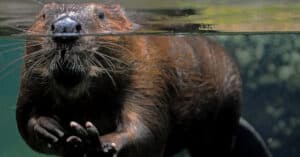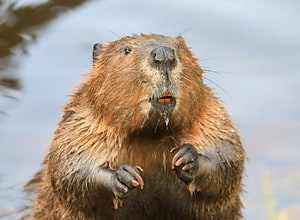Beavers can often look like smaller versions of bears. These little rodents are some of the most intelligent mammals in the world, capable of amazing constructs such as dams. These furry animals weigh an average of 60 pounds and can grow to about 50 inches in length. However, a beaver that weighed more than a black bear once existed and had six-inch teeth. Unbelievable, yeah? This article delves into the characteristics of these giant beavers, arguably the largest ones ever.
Phoberomys Insolita: The Largest Beaver Ever?
Phoberomys is a genus of giant beavers that lived between the Late Miocene and Pliocene periods in South America. These large beavers weighed more than ten times the size of a capybara, the largest extant rodent.
According to research, Phoberomys pattersoni weighed about 1,500 pounds, and Phoberomys insolita is believed to have weighed even more. Although there have been no extensive fossil discoveries of the large beaver, the six-inch teeth found indicates a larger size than the 1,500-pound Phoberomys pattersoni.
What Did Phoberomys Insolita Look Like?
According to reports, Phoberomys pattersoni was the size of a buffalo and was estimated to be about 4.2 feet tall and 9 feet long. This gives a rough estimate of Phoberomys insolita, which was larger. This giant beaver was larger than the largest black bear in history, which weighed only about 1,100 pounds.
Phoberomys insolita, like many giant beavers, was hairy and had wide tails. These Phoberomys beavers had larger hind legs compared to their smaller front limbs. While these giant beavers might not have stood taller than the average human on their four limbs, they would have been quite menacing if they towered on their hind legs alone.
What Did Phoberomys Insolita Eat?
Phoberomys insolita was a herbivore. These beavers ate leaves, aquatic plants, and possibly tree bark. It is believed that these giant beavers held onto their food with their front limbs as they ate. A notable feeding feature of Phoberomys insolita was its large incisors, with which it would have torn tree barks and leaves before consumption.
Beavers are known to have unique teeth, especially their four strong incisors which contain iron that makes their teeth quite durable and strong enough to bring down a tree.
Phoberomys Insolita Habitat: Where and When It Lived
Phoberomys insolita lived in ‘Mesopotamiense’ in the late Miocene period, which is modern-day Entre Ríos Province in Argentina. These animals lived in marginal lagoons, swamps, savannas, and wetlands. One of the many attributes shared by the giant beavers and the smaller modern relatives is their semi-aquatic nature.
The Phoberonyms Insolita Threats and Predators
Little is known about the predators of Phoberomys insolita. This giant beaver would have towered over many animals in its environment. Scientists believe that a lack of suitable predators, competitors, and the isolation of South America in the Late Miocene period allowed these beavers to grow really large. It is believed that the continent was predominated by herbivores for a time.
However, predators could have emerged on the continent during the Pliocene period. Due to the massive size of Phoberomys insolita and its sluggish girt, it might not have been able to flee or burrow quickly to escape any predator.
Discoveries and Fossils: Where Phoberomys Was Found

Phoberomys is a genus of giant beavers that lived between the Late Miocene and Pliocene periods in South America.
©Gabriel Brzoska / CC BY-SA 4.0 – License
Most Phoberomys fossils found have been isolated teeth and cranial bone fragments. However, more complete fossils of Phoberomys pattersoni were found in the northern part of Urumaco town and El Hatillo in Venezuela, providing more information about the size and characteristics of these giant beavers. According to reports, the fossil included a partially shattered skull, pieces of a jaw, and femur.
Dental fossils of Phoberomys insolita were found in the Ituzaingó Formation of Argentina along with fossils of other species of the genus such as Ph. burmeisteri, Ph. praecursor, Ph. Lozanoi, and Ph. Minima. According to research, these four species, including Phoberomys insolita, have been classified as Phoberomys burmeisteri, with the differences in the fossils believed to be individual and ontogenetic variations.
Other fossils of Phoberomys beavers were found in Brazil and Peru.
Extinction: When Did Phoberomys Insolita Die Out?
Phoberomys insolita existed during the Late Miocene period, a treacherous time for many herbivores that went extinct due to vegetation changes. However, according to reports, animals like the giant beavers survived, while animals with shorter teeth perished.
During the Pliocene period, the shifting of tectonic plates created a land connection between North America and South America, allowing the migration of land animals between the two continents. The large animals in this epoch resembled many alive today, such as the giant ground sloth. The extinction of animals during this period was believed to have been caused by newer animals and climate changes.
Is Phoberomys Insolita Really the Largest Beaver Ever?
Phoberomys insolita is believed to be the largest beaver ever. However, over the years, other species of giant beavers were discovered and some became contenders. Some notable giant beaver species are:
1. Castoroides

The skeletal remains of the Giant Beaver show the immense size of the creature.
©Steven G. Johnson / CC BY-SA 3.0 – License
Castoroides beavers were alive during the Pleistocene period. These giant beavers belonged to a different family from Phoberomys; the Castoroidae family was endemic to North America. Castoroides weighed between 250 to 275 pounds and grew to about seven feet. Despite being referred to as giant beavers, these extinct rodents were smaller than Phoberomys beavers, being about six times smaller. However, a notable similarity shared by both species is their six-inch incisors.
2. Josephoartigasia monesi

Josephoartigasia monesi is the largest rodent to ever exist.
©Andrés Rinderknecht & Ernesto Blanco; Illustration: Gustavo Lecuona / CC BY-SA 2.5 – License
Josephoartigasia monesi is arguably the largest known rodent ever. The large beaver weighed about 1,100 pounds and had respective heights and lengths of five and nine feet. The discovery of the large South American rodent came later than Phoberomys insolita in 1987 but was described in 2008. Josephoartigasia monesi lived on the continent between the Pliocene and early Pleistocene periods, about four million years ago. The estimate of its size was made from the discovery of a complete skull.
Up Next:
Beaver Teeth: Everything You Need to Know
The Largest Black Bear in History
The photo featured at the top of this post is © Gabriel Brzoska / CC BY-SA 4.0 – License / Original
Sources
- Orangel Aguilera, Available here: https://www.researchgate.net/figure/Phoberomys-pattersoni-A-Entire-array-of-elements-of-skeleton-Universidad-Nacional_fig1_9087813
- , Available here: https://www.researchgate.net/publication/9087813_The_Anatomy_of_the_World's_Largest_Extinct_Rodent
Thank you for reading! Have some feedback for us? Contact the AZ Animals editorial team.






